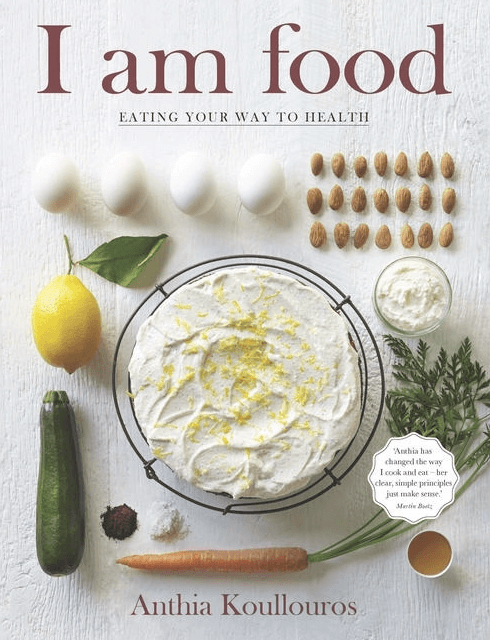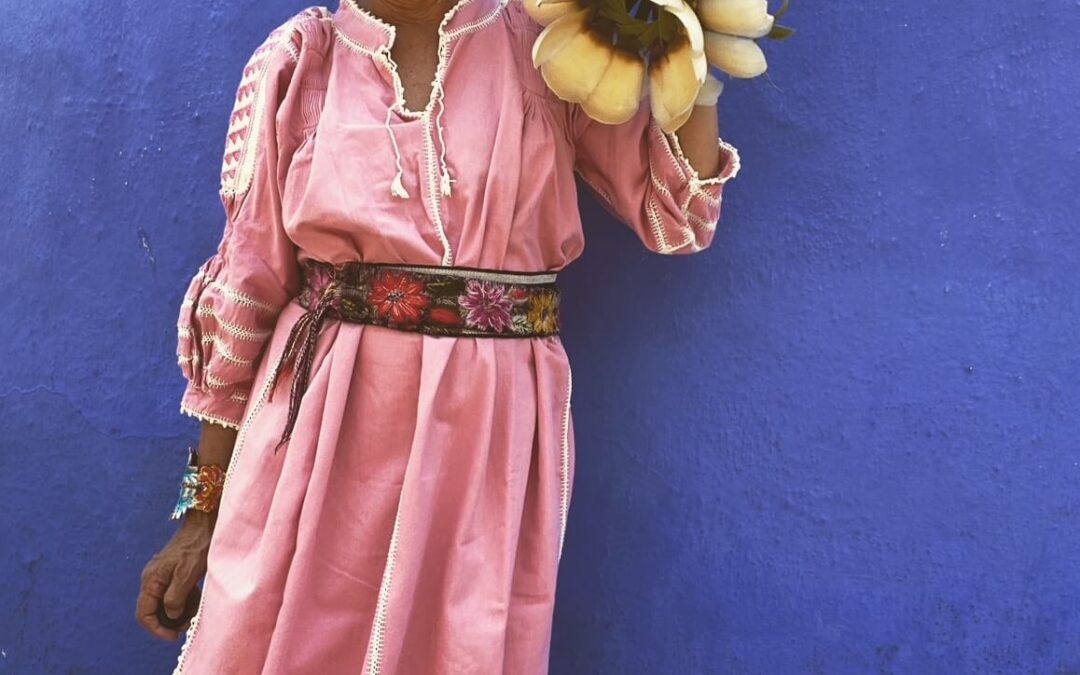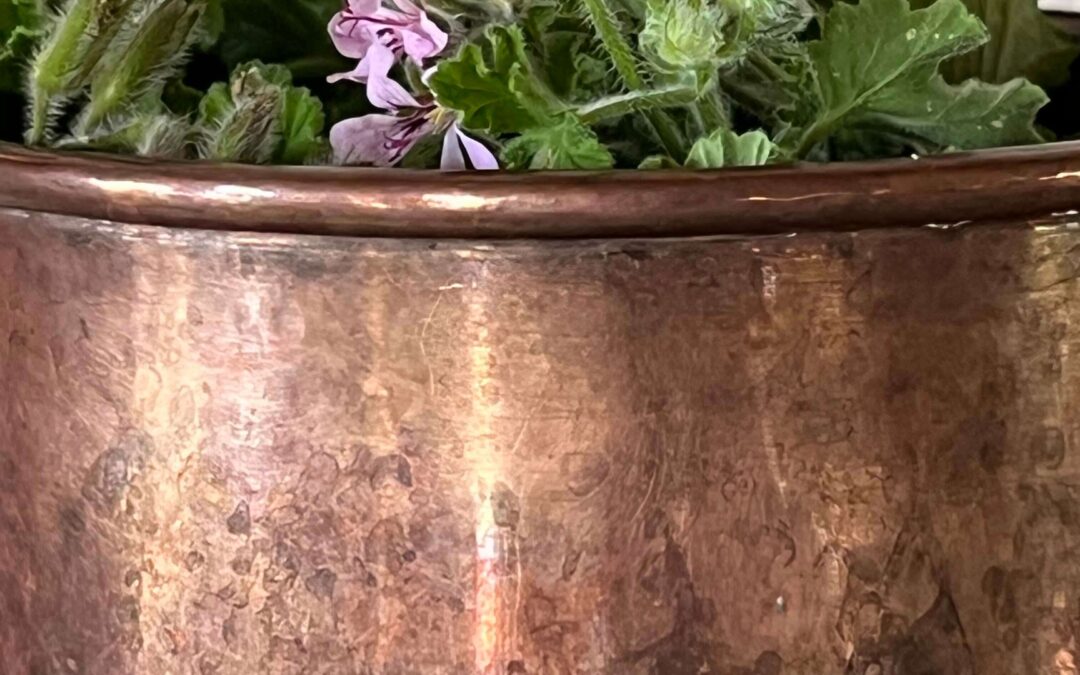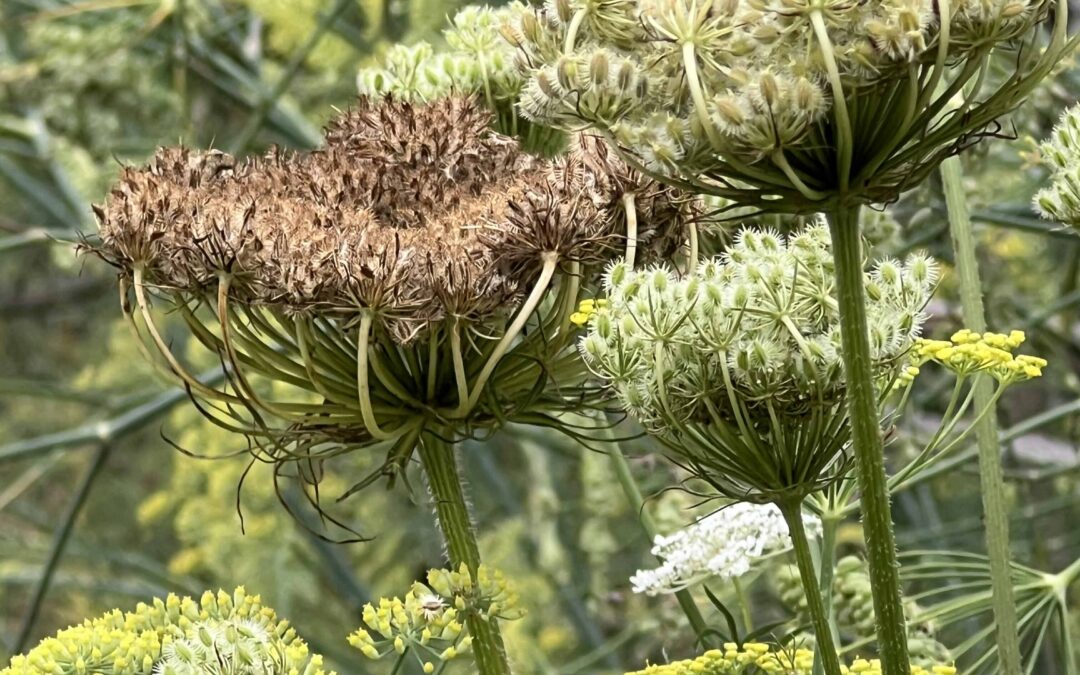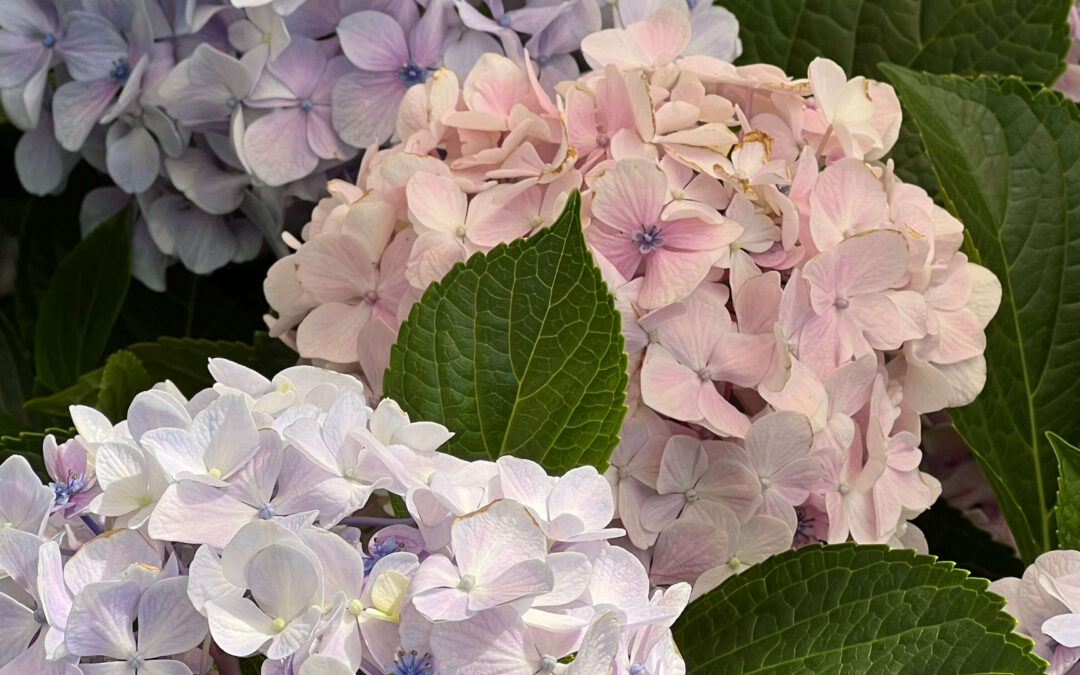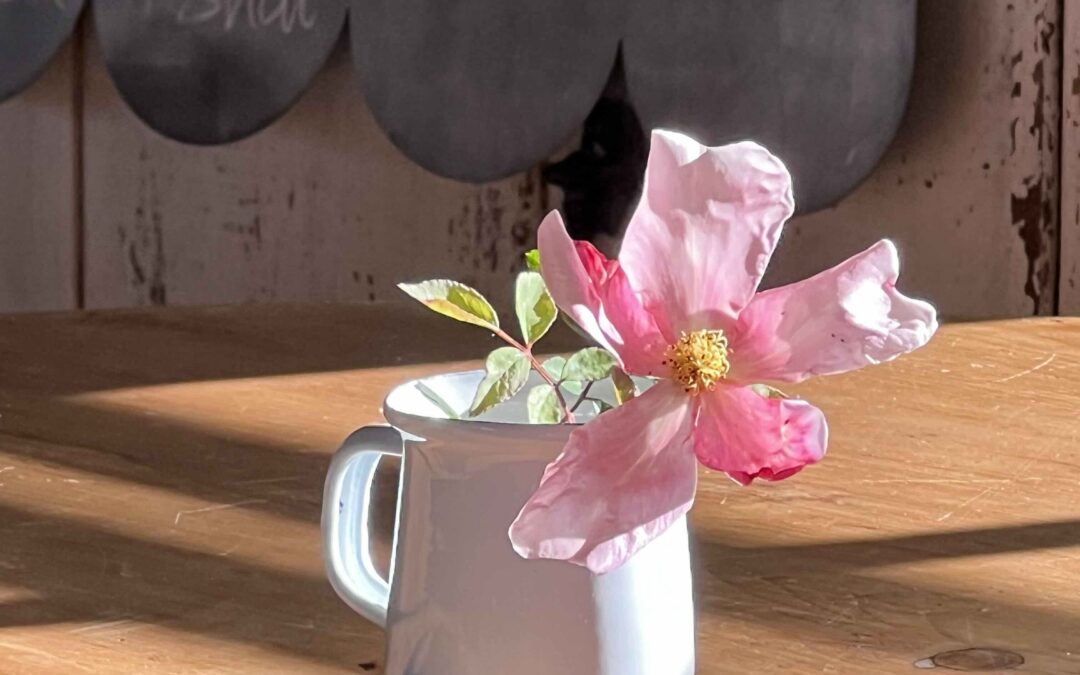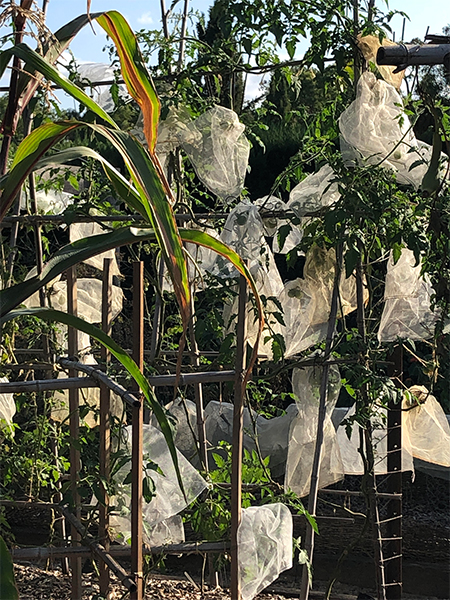
Play podcast
It’s the beginning of March, when summer’s on its last legs and tomatoes kick up their heels….
Funny how an autumn change seemed to steal away the last days of summer….it was early and felt a bit abrupt, and now we’re in for another few days of sweltering heat! As I said during this episode…our weather twists and turns its way from one season to the next. Our long hot evenings are vanishing though; we’re losing light sooner…surely it’s been getting dark a good half hour earlier this last week! How I dread the demise of sunlit evenings, though the late afternoon and evening light is glorious and will only get better as we streak into autumn.
Do you recall how I said in the introduction that at times our landscape is green and lush, at others parched and bleached? Well, it’s not parched right now….thanks to the summer storms that have well and truly rolled away, but our paddock grasses are bleaching out, which is a vision I find bewitching.
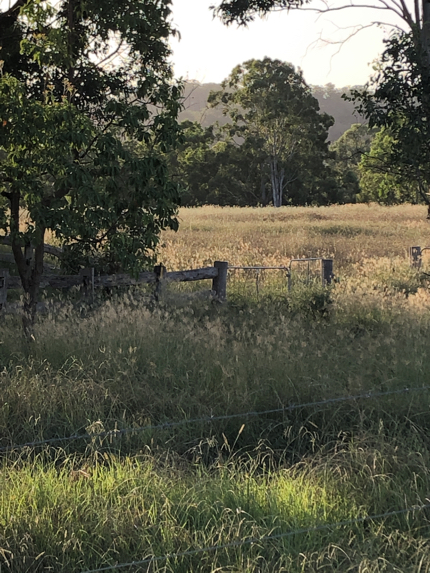
The last throes of summer inevitably mean many leaves in the kitchen garden are shrivelling now….drying out as they lose the will to thrive.
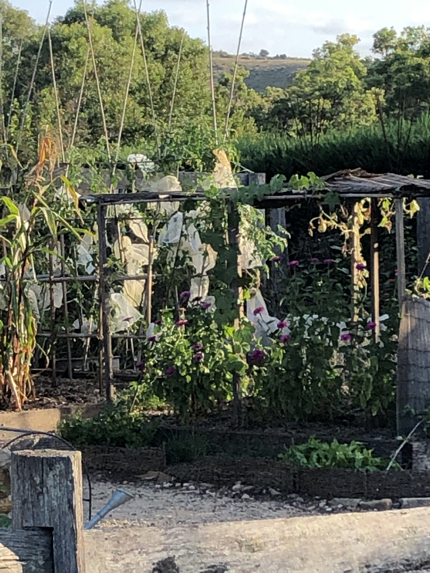
Yet others are fresh as a daisy. Like the tomatoes; and as long as I keep on removing spent foliage, the vines replace them with leaves anew. Some are even sending out new shoots at the base, which….at this time of the season, are still worth encouraging, as there’s a good chance new stems will have time to produce fruit before the real chill sets in.
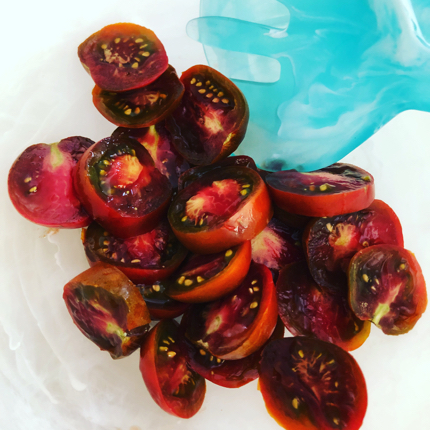
As tomatoes are the stars of the show by now, during this period of bounty I want to encourage production of as many fruit as I possibly can. Aside from cooking some of the main crop to store for the season ahead, eating fresh from the vine is the order of the day. Just add a drizzle of olive oil, a torn basil leaf, a little labne or chèvre to a plump ripe tom for a simple lunch.
If I can persuade you to bake Belinda Jefferey’s delicious Pumpernickel Soda Bread (which is a recipe I could simply no longer live without); to whip up a batch of Baba Ghanoush and one of basil pesto or pistou; then to add some olives and perhaps a little prosciutto; you will have a late summer/early autumn match made in heaven.
This is the first season I’ve grown Arthur’s Big Fat Greek Tomato; which I gather comes from Arthur’s family farm in Petri, Greece. I picked up a seedling in late Spring at Tim’s Garden Centre on a whim…I usually grow all my tomatoes here from seed, but what an explosion of dense texture and taste that first fruit embodied! There are a lot more growing on, which is exciting. (I forgot to save the ‘insta story’ image but will take another with the next specimen!). We shared the first Costoluto Genovese the other day, which was equally delicious….so perhaps now you can see just how long it really takes for these large varieties to mature and produce their flavoursome fruit.
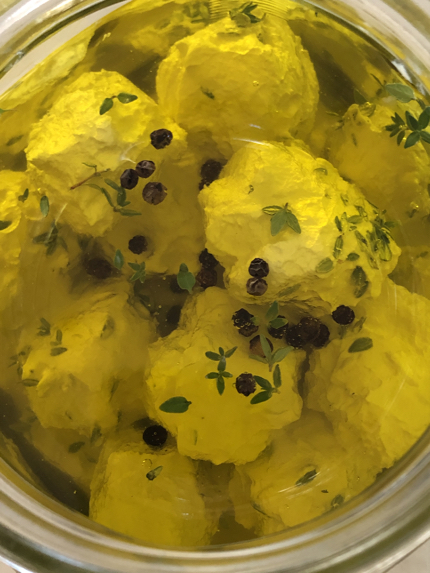
I’ve never tried to make Labne before, but thanks to an enthusiastic Sunday instagram post by Belinda that made it look so incredibly simple….it is….I did! You’ll find the recipe on her instagram page @belindajeffereyfood which she was so generous to share. Sometimes, we all just need a gentle little kick along; and I was excited to add these textured little dairy dumplings to the table at our first inThe Kitchen Garden event lunch of the year.
All the produce in the garden right now, combines to the most delicious effect.
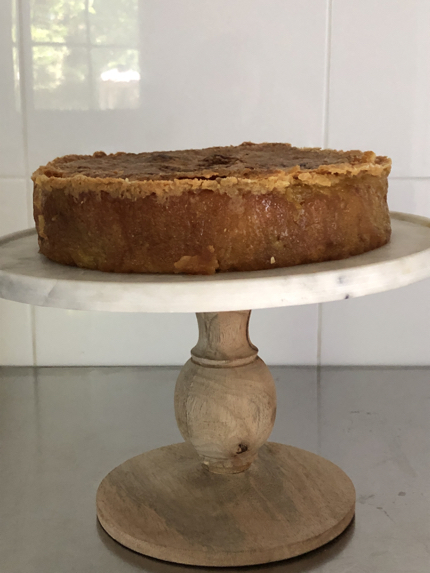
While I seem to have got myself side-tracked on the topic of eating….how truly excited I was to bake the ‘Au Pair’s Apple Cake’ using our own apples for the very first time! To double the recipe on a whim for morning tea at that inThe Kitchen Garden day was a leap of faith…I’m sure anyone sensible would do a trial run to see if it worked, but there wasn’t time and thanks to those individual nets, there were apples! So…..

The recipe is in The House and Garden at Glenmore, and if you’re keen to give it a whirl, yes you can double the quantity, but don’t quite double the apples…I used about 850 – 900g…which already seemed like overload! And I used a 22cm, rather than a 20cm tin. Good luck! Let me know how you get on…
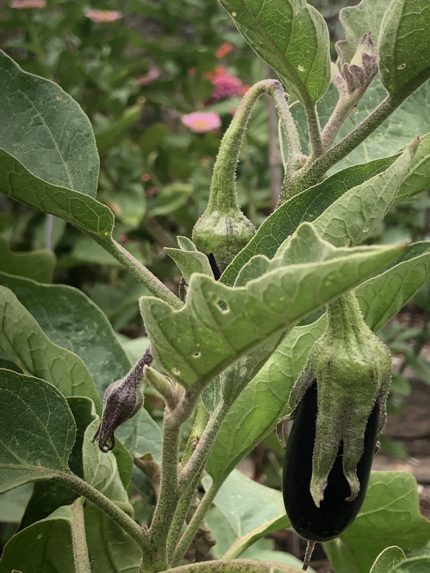
The aubergines have been increasing in number for weeks now…hence the lovely bowl of Baba Ghanoush at our inThe Kitchen Garden lunch, as well as plenty left over for us too! (That recipe is also in the book).
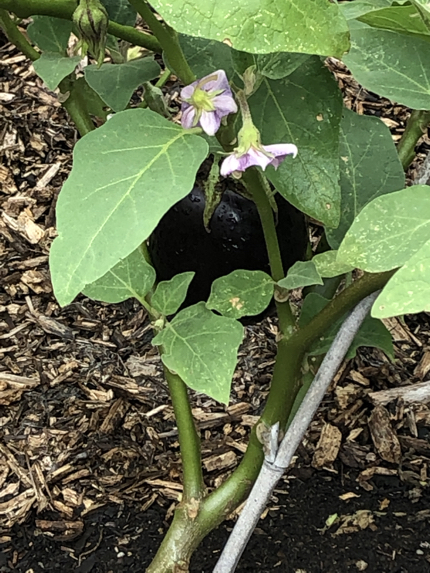
All summer long, the row of glossy dark fruit that develops from sweet mauve flowers, has been accompanied by a row of clear pink zinnias….which brings me to the tangent topic I just couldn’t resist during this episode!
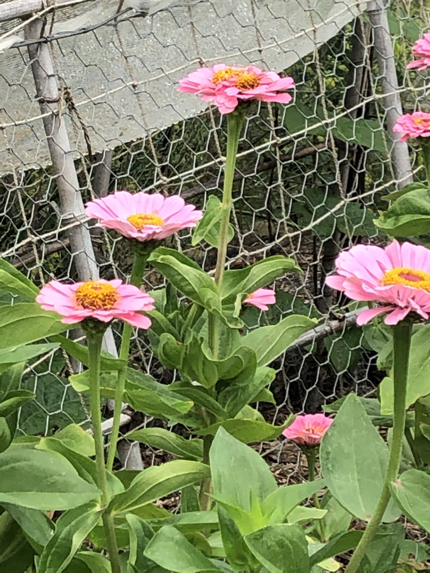
The vision of kitchen gardens laid out in traditional style have captivated me all my life…I remember standing in a kitchen garden that belonged to friends of my parents as a child, eating delectable peas straight from their pods. Perhaps this, along with Beatrix Potter’s Tale of Peter Rabbit, is where it all began!
One of my grandmothers grew vegetables on a large scale, in country NSW during the war; and although she gardened ’til she fell off her perch, unfortunately by the time I came along, her veg growing days were long gone.

Of course, since beginning the Kitchen Garden proper here, I’ve come to learn there are other approaches you can take to laying out a kitchen garden….as I’ve explained to you during the previous episodes: you know only too well by now, that I employ two methods here….the traditional beds to the right of the apple arch, and the guild, or intermingled beds to the left.
While I primarily leave them this way as an ongoing experiment (one method versing the other) and extremely useful teaching tool; it also gives me the opportunity to play…to incorporate rows of flowers into the traditional beds as an acknowledgement of the traditional style that has been such an inspiration to me. (While the tack I’ve taken with the guild beds allows me to play with romantic, meadow-like planting; a style with which I’m also much enamoured).
Of course it does no harm to set out rows of flowers amongst the veg…the flowers bring in bees, so the concept is in perfect harmony with the practice of companion planting. The only negative, in a small garden, is that the row takes up space that might otherwise be devoted to veg. But I’m happy to sacrifice a little space for something that brings me so much joy.
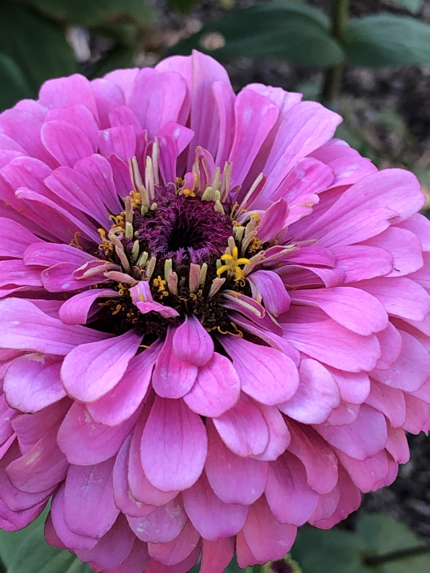
It also gives me the opportunity to grow the kinds of flowers that would look out of place anywhere else in the garden here, like annuals, or flowers that may be out of fashion, like Zinnias, with which I’ve had a long-time flirtation! (It all began long ago, with a delightful lunch on a little island near Venice; a crumbling wall aglow in the autumn sun and swathes of multi-coloured zinnias!).
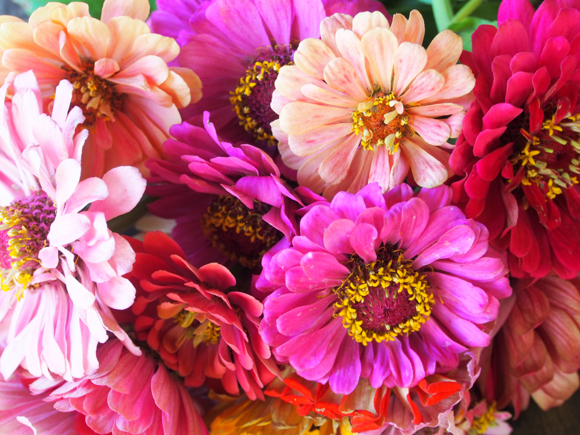
I sometimes plant them in mixed colours out in one of the floating beds or a corner down the back (but as you’ll have gathered from the episode, it didn’t work this time ’round). If you flick back through instagram, you’ll find my feed is littered with zinnias in season; and there’s a lovely picture of some ‘down the back’, in the book too.
But in the kitchen garden itself, I like to plant rows of individual colours, and the best supplier of these old-fashioned strains….the kind you imagine in your mind’s eye, that I’ve discovered, is Lambley.

The kitchen garden at the Lost Gardens of Heligan in Cornwall, UK, beautifully conveys the style I explained in the episode. What a vision of lilies here! Just imagine cutting armfuls of them to bring into the house! And the perfume…
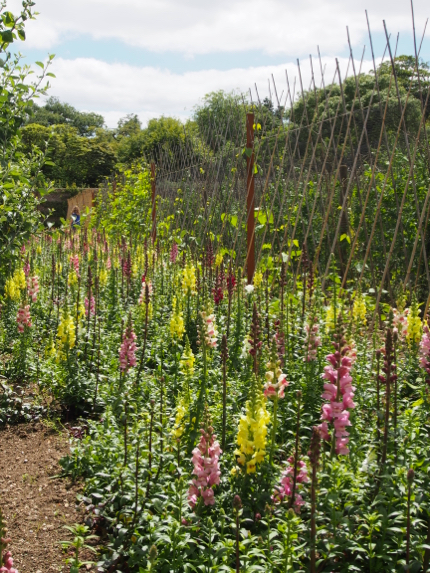
It was this vision a couple of years ago that had me scrambling to find Snapdragon seed and the closest I got was the ‘Rocket Formula Mixed’, also from Lambley. While I’d never be able to conjure a vision quite like this, the result wasn’t bad as far as very small scale goes! At least it put a smile on my face!
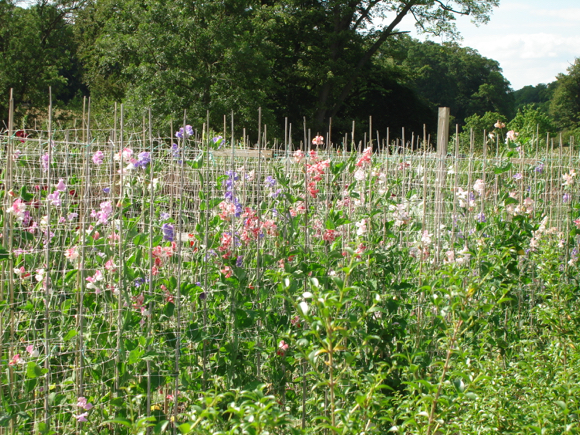
Then there were these sweet peas amongst the veg at a garden that for some reason you hear little about, but is one of the most enchanting I’ve ever visited: Easton Walled Gardens. While it actually holds the national UK sweet pea collection, and has a story a bit like that of Heligan, much of its garden is laid out with paths that are romantically mown through wild grasses, smothering an old rose here and there….simple…and simply captivating (or it was back in 2010…how the years fly!).
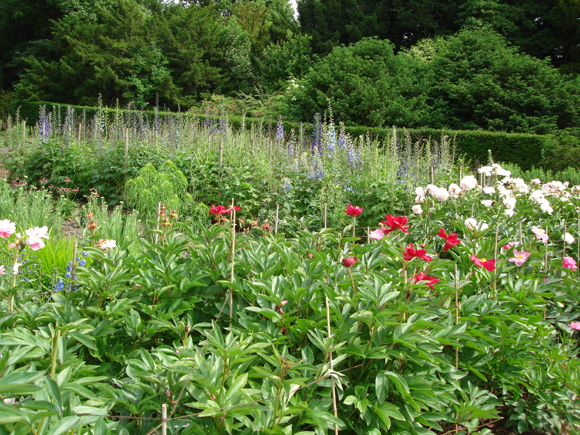
As I mentioned during this episode, the delphiniums and peonies in the kitchen garden at Chatsworth are indeed a vision splendid! This is a perfect example that clearly conveys the tradition of kitchen and cutting garden combined; where veg for the kitchen grow alongside flowers for the house. Practical….and beautiful at the same time.
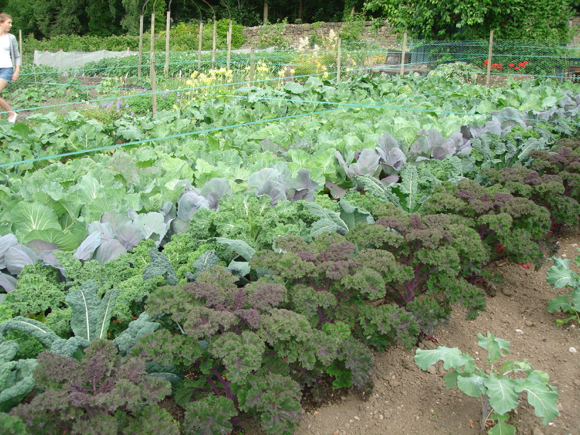
Oh but would you just look at those rows of brassicas!!!! At the time, they were next to the bed of cutting flowers. How lucky we are, to have these traditional examples to inspire (though if you revisit the notes for episode four, where I wrote about my favourite gardens, you’ll see how delighted I was that they also had one of the most beautiful examples of guild planting I’ve ever seen); so don’t think historic houses are at all behind the times. They are so often in the very fortunate position of being able to employ (and train) full-time gardeners, and are therefore able to set examples on many levels, so that the rest of us have the opportunity not only to be inspired, but to learn.
On a local note, though not planted exactly in this way but oh so close, many of you know that the kitchen garden at Vaucluse House is my favourite in this country. Again….revisit those Episode four notes!
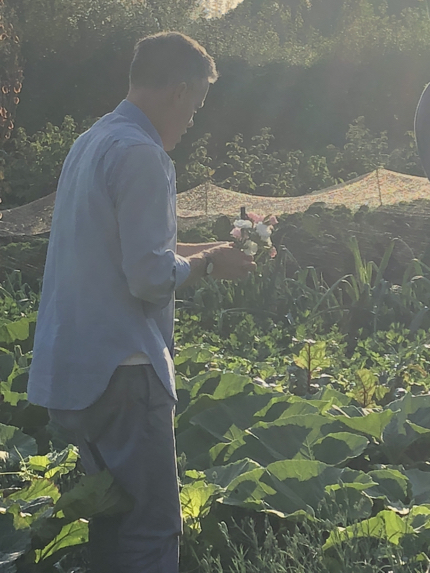
Of course, one of the finest examples of this style that you will discover anywhere on earth, is the Kitchen Garden at Great Dixter. (Again…revisit those Episode 4 notes for more, because Aaron’s practice exemplifies the method…and I probably have enough images from one brief visit to write a book!).
But I promised you a little tale, at the end of the tangent during this episode; about how I go about choosing plants for the garden here; so I’ll tell you, just for fun, and you can declare me bonkers if you like!
It’s a Dianthus, (carnation or ‘pink’) tale, that, it would seem, never ends!
When I first met Larry, (back in the dim dark ages for some of you!) his cupboard was well stocked with boxes of Savon Oeillet-Mignardise (carnation), by Roger & Gallet, Paris*. It was his mother’s favourite soap and the intoxicating clove scent of it rather informed our early days together. (His mother had died the year before we met, too early, sadly. She was half French and would buy the soap on her shopping trips to Paris….they lived in Scotland). So already, you gather the romantic thread of the soap scent, and its sentimental place in our lives. Well…we continued the tradition after we were married and brought numerous boxes of it to Sydney with us.
Dianthus were among the first plants I tried to establish in the garden here: in the first instance, because of their scent, but also because I so love their dear old-fashioned little faces, often with ‘pinked’ edges, as if a fairy has been busy cutting their petals through the night.
The Roger & Gallet boxes were illustrated with lots of single Dianthus blooms, and the funny thing is, the scent never leaves the box. Clemmie filled one with glitter and glue and other craft bits ‘n bobs, when she was very small….I came across it at Christmas, still filled with her ‘fairy dust’. I opened the lid and it smelt the same as when it was filled with the rounds of pleated, tissue-wrapped, beeswax coloured soap. Bonnie’s box is still in her desk drawer, filled with the tickets from every childhood play, concert or show she attended….along with the distinct clove scent.
Anyway, I hadn’t had much luck keeping the plants alive in our climate….we’re just too humid and the classic Dianthus ‘Doris’, a pale pink with darker central blotch, would just curl up her toes each year, so after awhile, I gave up. It was difficult to place her in the garden as other styles of plants more suitable to our environment, and an alternate overall aesthetic became better established here.
Then….at one Collectors’ Plant Fair, I spied two Dianthus plants on a stand that contained the kinds of plants I love but usually kill! (Mistydowns Nursery…surely the name says it’s all?!) But I tinkered with the idea of trying to grow them in pots, and I was so excited to bring those two seedlings home from the fair for Larry, as an Easter present. Well….they have been growing in pots, down at the Hayshed ever since and are thriving! Dianthus Robert and Dianthus Valda Wyatt. I get such a thrill from picking their few highly scented flowers, which mostly appear in the autumn.
So…we could leave the story there except….when I visited Great Dixter last year, I had to smile when I discovered a little posy of Dianthus sitting on my bedside table! When I quizzed Aaron, he said they were growing in the Kitchen Garden…he’d show me….and they were.…a whole long row of them! Alongside the rows of cabbages and his incredible pumpkins! I can’t tell you how excited I was. But there’s more….he told me the Roger & Gallet soap was also Christopher Lloyd’s favourite (which makes sense…he’d have been of the same era as Larry’s mama).
Then, when I took myself off to bed that night, I randomly plucked a book from the shelf in my room. Exhausted, I knew I wouldn’t keep my eyes open long, so a slim volume by Vita Sackville West seemed a good idea…when the chapter that fell open was about ‘Paisley Pinks’. How extraordinary! And if that wasn’t enough, when I returned home to open the copy of Gardens Illustrated on my bedside table, that I hadn’t had time to look at before I set off on that very quick trip, what did I find? A whole article…pages of it, devoted to Dianthus….it was their ‘plant of the month’! Well….that surely just about finishes it off, doesn’t it? Do you think it means they’re back in fashion?!!
On one last note, I asked Aaron about growing them in the ground, the varieties he plants, but on return couldn’t find the seed here. So I turned to my Lambley catalogue and…yes, you guessed it! I found what looks like a rather enchanting variety called ‘Chabaud Orange Sherb’. It’s a French heirloom carnation dating back to the C19th and apparently, has a ‘delicious sweet spicy clove fragrance’. I ordered my seed and got it underway on the potting bench in November (the earliest opportunity). With any luck, an experimental row will join my brassicas this coming season! Oh how I hope they work….I’ll keep you posted!
If nothing else, this little tale just confirms my belief that gardens hold so much more than the face they present to the world….they contain stories, connect people, thoughts, ideas and memories, across generations.
(*It looks like Roger & Gallet still make the soap but the packaging has been modernised!) and I’m sorry I don’t have any images of the ones here….I know I do somewhere, but they’re not showing themselves right now, so if I find them down the track, I’ll slot them in!

In the meantime, we enjoyed around a dozen of the most deliciously perfumed, velvet-fleshed peaches from the tree. Again, those individual nets have made such a difference, and while you couldn’t net a whole tree this way, for espaliered trees I’ve found them to be hugely advantageous. And a dozen fruit is better than sometimes none in years gone by.
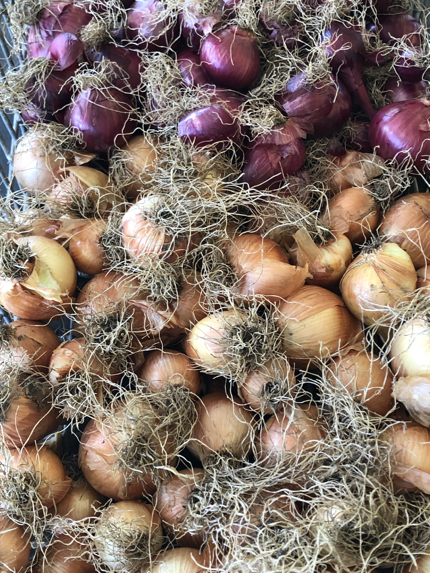
The onions, that I mentioned I’d upended in a wire basket in the last episode, for their final drying, have all gone off to the cellar now, to store. Along with the garlic.
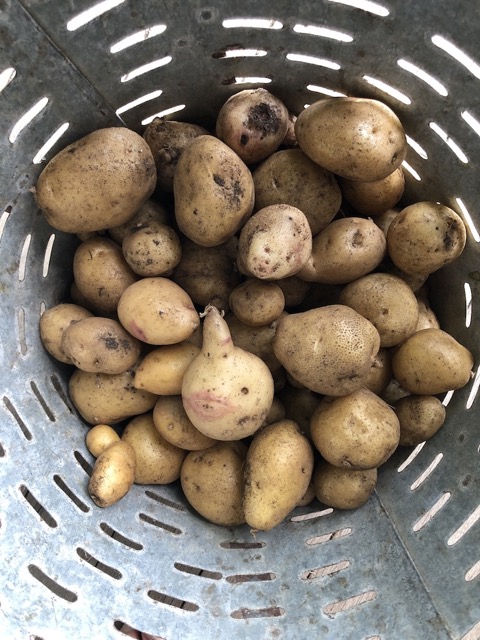
To be joined by a jumble of potatoes….
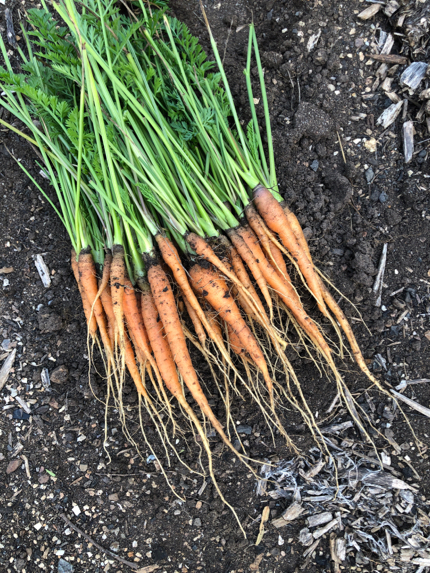
Those carrots, that I told you had their foliage ‘trimmed’ by some scavenging animal last month, have obviously been doing their best to grow on underground. And while they’re on the smaller side of those sold as ‘Dutch’ in the shops, they have a rich taste and delicious texture. They are trying, poor things, to re-grow their foliage, but I can’t give them too much longer in this spot, because the one crop I won’t compromise my timing on, are the broad beans. So the last of this row of carrots have only a couple more weeks to do a bit more growing before I pull the lot!
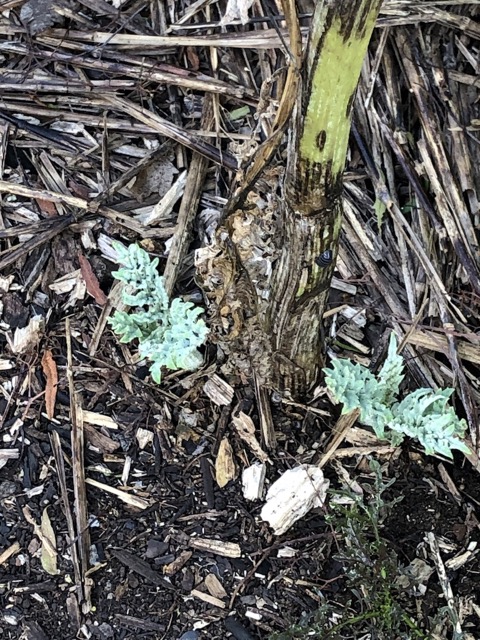
Here are the tiny new artichoke leaves that I mentioned emerged at the base of the spent flower stalks, indicating the time was right to cut the old stalk out at the base.
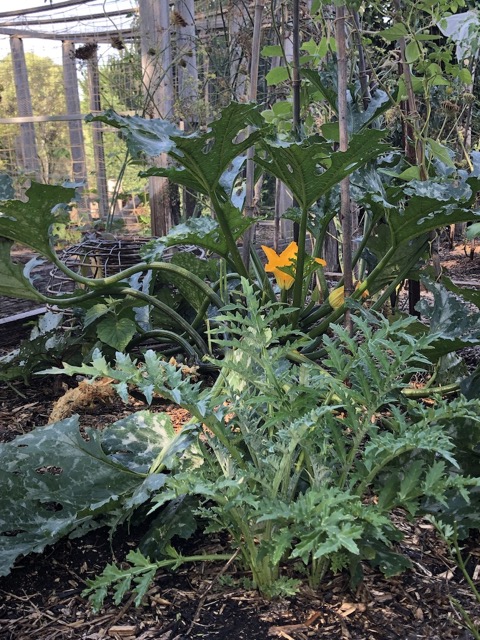
And just a couple of weeks later, look how quickly they’re growing into the coming season’s handsome specimens! They will soon eclipse those of the zucchini behind, as it fades from being the focal point of this summer bed.
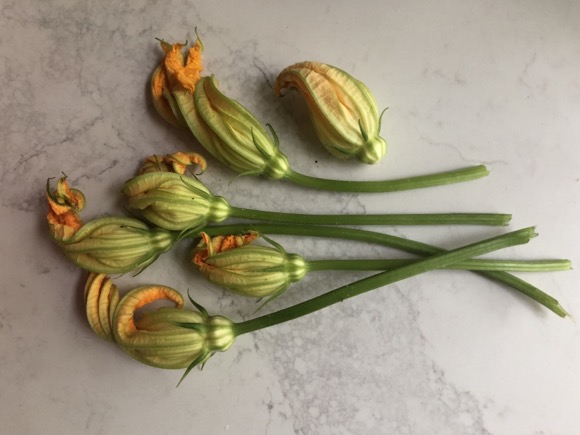
And while I think of it, after those male zucchini flowers fold their petals once their job is complete, I see no reason not to use them…picked before they completely shrivel and drop from their stalks. Just tear them into shreds and toss gently for a minute or so in olive oil to scatter over dinner in a final flourish!

New growth at the base of old fennel stalks tell us it’s time to cut the old stalks down to the ground….I find cutting just above that first ‘ring’ you can see around the stalk in this image, is a good spot to make the cut.
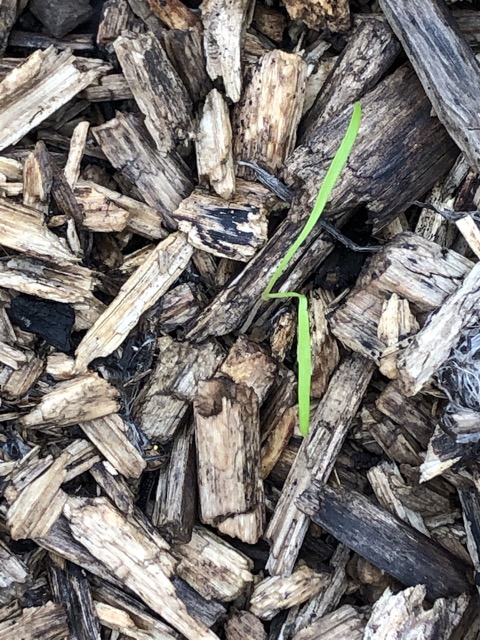
This fragile new fennel seedling that I discovered on the morning I recorded this episode, tells us it’s time to spill the seed wherever we may want fennel to grow.
So you know what that means! I’m ready to collect as much seed as I possibly can, to sow around and about, to make pretty visions (as well as to provide lots of pollen for our bees and to encourage ladybirds who love their flowers so much)….for our Open Garden in November!

In the meantime, pumpkin vines romp along fences….
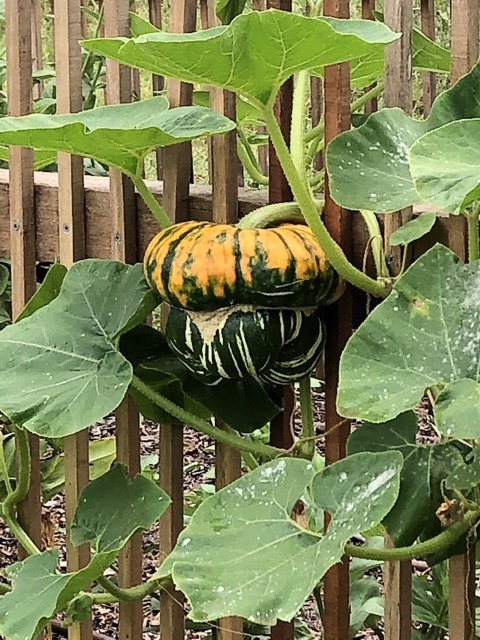
Some sport an occasional fruit. They still have a lot of work ahead, straddling the seasons before they’re spent.
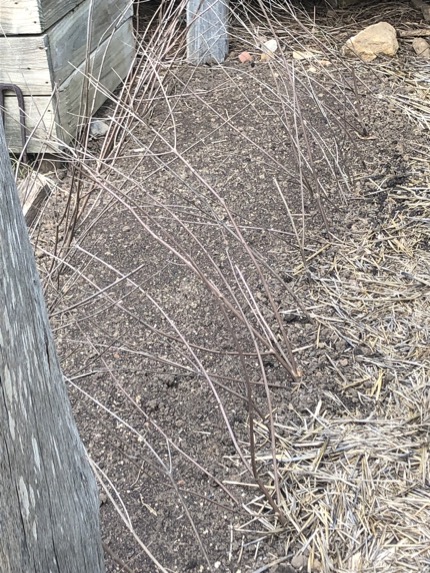
While the very first sowing for next season is already done. Parsnip seed can take ages to germinate, so patience is required.
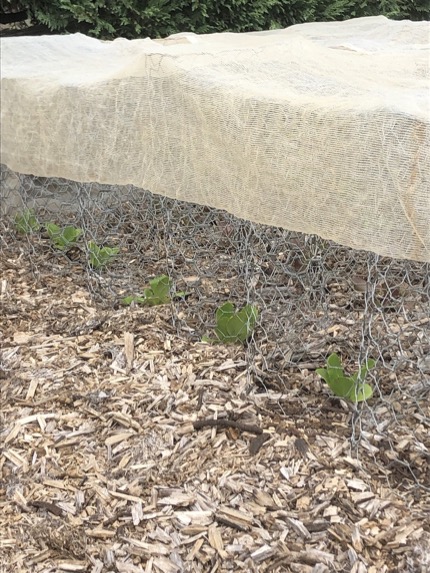
So anxious am I to get the next batch of lettuces underway for us to eat, that I picked up several punnets of our very favourite hearting ‘Butter’ and ‘Mignonette’ varieties at Neil & Carmen’s stall at the markets last weekend. But I am concerned it’s still too hot to plant, so the ones that aren’t under the leafy green canopy in the garden proper, down the back, are each in a cylinder, with a temporary net overhead to provide a bit of protection from the elements. These should be a quick crop here, while the season is betwixt and between.
Some of you will have met Neil and Carmen here at previous Open Garden weekends…I very much hope I can persuade them to join us again in November, but they visit Camden, Cobbitty, Berry and Bowral, Kiama and Mittagong, Blackheath and Castle Hill on a regular basis. I think they were clever, to set up a system years ago, whereby you don’t have to buy an entire punnet of one variety of plant, but can choose whatever you like: so if your space is small, you might fill your punnet with one of this, two of that…making it up as you go along. And their seedlings are eye-poppingly fresh!
Along with those hearting lettuce I mentioned, to be honest, I tend to buy my Brassica seedlings from them too, and fennel seedlings, celeriac, onion and leek…when the time is right. They are inclined to have some uncommon herbs too…they are the source of all my precious lovage plants!

Up at the house, you can see just how tall the Jerusalem artichoke plants grow! They’re rather ungainly I guess, but I’ve grown them here for so many years now that I can’t imagine putting them anywhere else! They’re in bud, if you look very closely, so by next time, I should be able to show you their flowers…but I imagine you can see now, why I don’t want any unexpected gusts of wind! Of course, it will happen, it always does….but the longer they stay upright, the better!
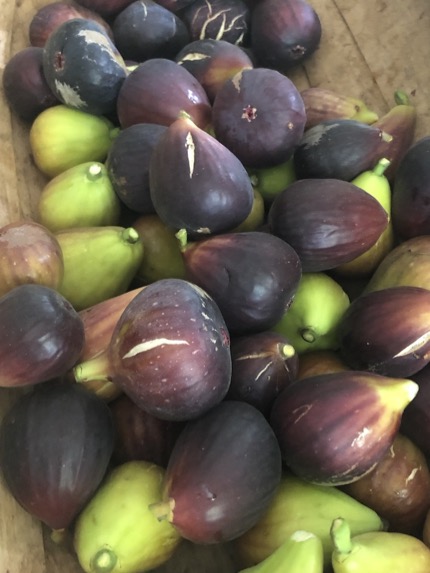
And then there are the figs….the luscious, delectable figs. They’re coming in at a rush now and it’s all I can do to keep up! The dark ones, of this lot (that I’m pretty sure are ‘Black Genoa’s’) are heading to friends, while the ones that look more green, are, I think ‘Brown Turkey’s’ and are heading for another batch of jam.
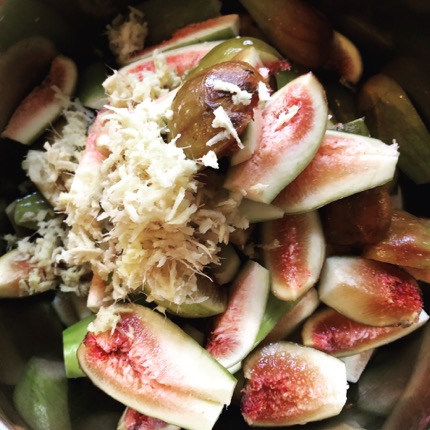
Neither were labelled varieties when I planted them….the brown came from one of the members of the Moore family from who we bought Glenmore 30 years ago…Zetta gave me a pair of saplings grown from cuttings from her own trees right back at the very beginning.
And the dark ones came from a roadside stall on Camden Valley Way, where I used to stop sometimes on my way back from Sydney to collect the girls at the local school. I thought they were the best figs I’d ever tasted and one day, there were saplings for sale! But trees like that don’t come with labels. All I know is that the dark make the best eating and the brown the best jam.
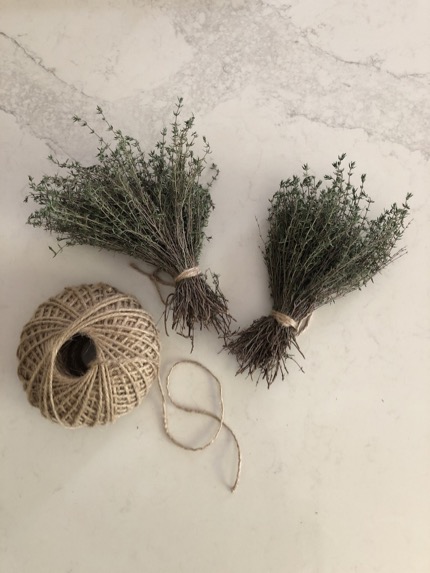
On that note, while there are plenty of jobs on a large scale that will need to be carried out in the weeks ahead, there are some delightful little tasks too. Like cutting back some of your herbs, either to dry and store for the cool season ahead, or, as ours are inclined to just keep on growing, to tie into pretty bunches.
So….’til next time, happy eating; planning, and prepping for the season ahead!

| Going, going…… | lettuce, which is a great shame. |
| Eating…. | lettuce (the last), zucchini, cucumber, aubergines, tomatoes, corn, carrots, potatoes, grapes, rhubarb, apples, figs, fennel buds, basil, sorrel, salad burnet, lovage, chives, French tarragon, parsley, very first calendula petals. We ate lots of mint when I cut the plants back hard! They’re re-shooting now. |
| Sowing seed of…. | fennel, carrot. Rocket, red elk and giant red mustard to follow …at least once this latest wave of heat passes. Similarly, once the temperature dips a bit, peas and broad beans. |
| Planting seedlings of… | lettuce, fennel, coloured chard. kale, broccoli, cabbage, cauliflower, kohl Rabi. I’d like to say Brussels sprouts but I know they don’t like me like I like them! |

